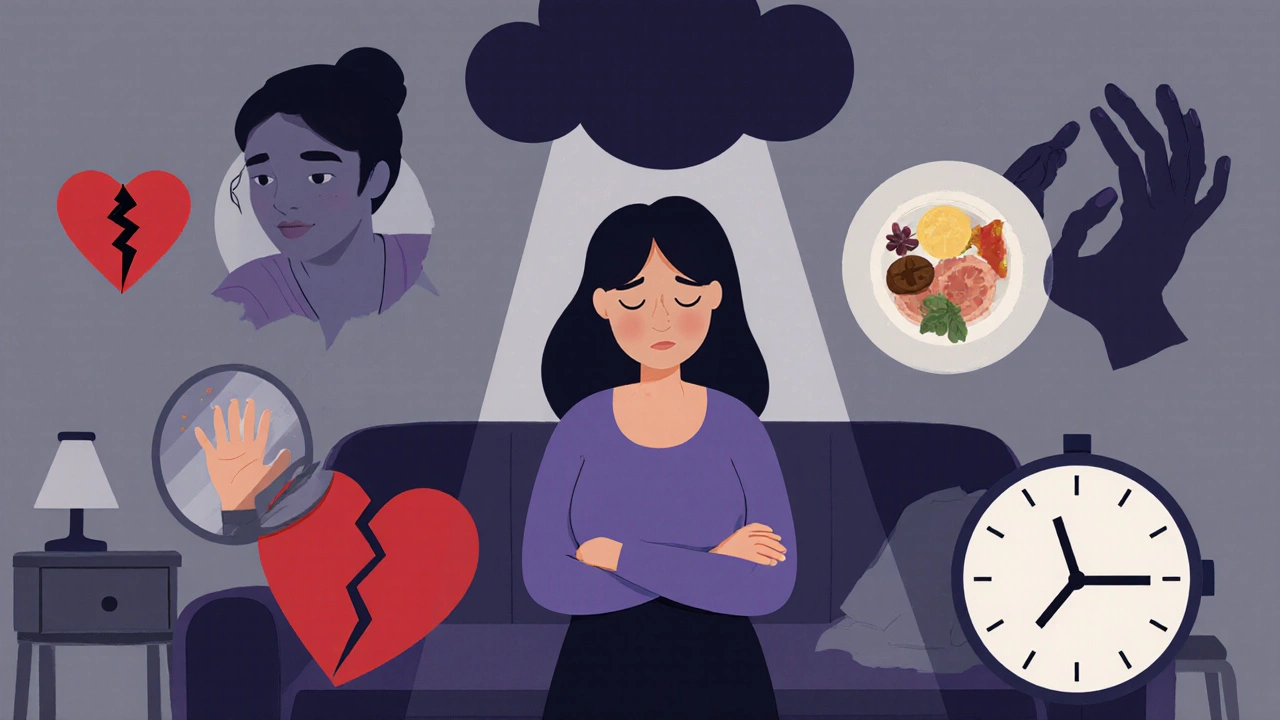Bringing a new baby into the world should feel magical, but for many mothers the weeks and months after birth can turn into a fog of sadness, anxiety, and overwhelm. Recognizing what’s happening and knowing where to turn for help can make all the difference.
What is postpartum depression?
Postpartum depression is a mood disorder that can develop after childbirth, marked by persistent low mood, loss of interest, and feelings of hopelessness that last longer than the "baby blues". It’s not a sign of weakness; hormones, sleep loss, and the sudden lifestyle shift all play a role. In Australia, roughly 1 in 7 new mothers experience clinically significant symptoms within the first year.
Common symptoms to watch for
Symptoms can show up anytime in the first 12 months, and they often overlap with everyday exhaustion. Knowing the red flags helps you act early.
- Persistent sadness that doesn’t lift even on good days.
- Intense anxiety or panic attacks, especially about caring for the baby.
- Feeling detached from the newborn or unable to bond.
- Loss of pleasure in activities you used to enjoy.
- Changes in appetite or weight - either loss or gain.
- Sleep disturbances beyond the normal newborn interruptions.
- Thoughts of self‑harm or hopelessness.
If any of these linger for more than two weeks, it’s time to consider professional help.
When to seek professional help
Waiting for the "right moment" often lets the condition worsen. Here are three clear signs you should call a healthcare provider:
- Thoughts of harming yourself or your baby.
- Inability to care for basic needs (eating, hygiene, feeding the baby).
- Symptoms that interfere with daily functioning for more than two weeks.
Australian hospitals and community health centers offer free postpartum mental‑health screenings. Ask for the Edinburgh Postnatal Depression Scale - a short questionnaire that helps clinicians gauge severity.

How to find support
Support comes in many shapes, and you don’t have to choose just one. Below are the most common routes and what to expect.
- Professional therapy: Psychologists or counsellors trained in perinatal mental health use cognitive‑behavioural techniques to reframe negative thoughts.
- Medication: Certain antidepressants (e.g., sertraline) are considered safe for breastfeeding mothers. A psychiatrist can guide dosage and monitor side effects.
- Support groups: Peer‑led groups, both in‑person and online, provide a non‑judgmental space to share experiences. Look for groups affiliated with Prenatal and Postnatal Mental Health Australia.
- Telehealth services: Many Australian states now fund mental‑health video calls, making it easier to fit appointments around infant care.
- Partner & family involvement: Encouraging partners to attend appointments can improve outcomes. Open communication about feelings reduces isolation.
Treatment options at a glance
| Option | How it works | Pros | Cons |
|---|---|---|---|
| Therapy (CBT, IPT) | Talk‑based techniques that rewire negative thought patterns. | No medication side‑effects; builds coping skills. | Requires regular appointments; may take weeks to see improvement. |
| Antidepressants | Regulate brain chemistry to lift mood. | Often faster symptom relief; can be combined with therapy. | Potential side‑effects; concerns about breastfeeding safety. |
| Support groups | Peer sharing and validation. | Low cost; reduces stigma; builds community. | May not address severe clinical symptoms alone. |
| Telehealth counseling | Remote video sessions with licensed professionals. | Convenient for new moms; often covered by Medicare. | Requires stable internet; less personal connection for some. |

Self‑care tips you can start today
While professional help is critical, everyday habits can ease the burden.
- Prioritize sleep: nap when the baby naps, and enlist a partner or family member for short shifts.
- Stay nourished: simple, balanced meals (whole grains, protein, veg) keep energy stable.
- Gentle movement: short walks or post‑natal yoga boost endorphins.
- Limit caffeine and alcohol, which can worsen anxiety.
- Write down three things you’re grateful for each day to shift focus.
These small steps aren’t a cure, but they create a foundation for recovery.
Talking to your partner and family
Many new mothers feel pressure to "be strong" for everyone else. Opening up can feel risky, but honesty usually strengthens relationships.
- Use "I" statements: "I’m feeling overwhelmed and need a break."
- Ask for specific help - e.g., "Can you take the baby for an hour while I call my therapist?"
- Invite them to attend a screening appointment; seeing the professional’s perspective reduces misconceptions.
When partners understand that postpartum depression is a medical condition, they’re more likely to provide the patience and practical support needed for recovery.
Frequently Asked Questions
Can postpartum depression happen after a vaginal delivery?
Yes. The type of birth does not protect against mood changes. Hormonal swings, sleep loss, and the emotional weight of caring for a newborn are common triggers regardless of delivery method.
Is it safe to take antidepressants while breastfeeding?
Many antidepressants, such as sertraline and paroxetine, have low levels in breast milk and are considered safe. Always discuss medication choices with a psychiatrist and a pediatrician.
How long does postpartum depression usually last?
With treatment, most women see noticeable improvement within 6‑12 weeks. Untreated cases can persist for a year or more, affecting both the mother and child’s development.
Can fathers experience postpartum depression?
Yes, partners can develop "postpartum mood disorder" or "paternal postpartum depression" due to stress, sleep loss, and role changes. Recognizing symptoms early benefits the whole family.
What should I do if I suspect my partner has postpartum depression?
Encourage them to speak with a GP or mental‑health professional. Offer practical help-like taking over night‑time feeds-to free up time for therapy or counseling.
Postpartum depression can feel overwhelming, but you don’t have to navigate it alone. Spot the signs, reach out to trusted professionals, lean on supportive people, and give yourself permission to heal.


Adam Craddock
Postpartum depression remains under‑detected despite robust epidemiological evidence linking it to adverse maternal outcomes.
The prevalence figure of roughly one in seven Australian mothers underscores a public‑health imperative that cannot be ignored.
Hormonal fluctuations, particularly the abrupt decline in estrogen and progesterone, interact synergistically with chronic sleep fragmentation to destabilise affective regulation.
Moreover, neurobiological models suggest dysregulation of the hypothalamic‑pituitary‑adrenal axis contributes to heightened anxiety and intrusive rumination.
Clinicians therefore recommend routine screening using validated instruments such as the Edinburgh Postnatal Depression Scale at both six‑week and six‑month intervals.
A score exceeding the established threshold should trigger a tiered response that includes psycho‑education, referral to perinatal mental‑health specialists, and, when indicated, pharmacotherapy.
Cognitive‑behavioural therapy has demonstrated efficacy in normalising maladaptive thought patterns while preserving maternal‑infant bonding processes.
In parallel, selective serotonin reuptake inhibitors, most notably sertraline, possess favourable lactation safety profiles that alleviate concerns regarding infant exposure.
It is essential to communicate that medication decisions are collaborative, evidence‑based, and tailored to the individual’s symptom severity and breastfeeding status.
Community‑based support groups provide peer validation and reduce stigma, which in turn facilitates treatment adherence.
Telehealth platforms have emerged as a pragmatic solution for mothers residing in remote regions, offering video‑conferenced psychotherapy that aligns with fragmented caregiving schedules.
The integration of partner and family involvement has been shown to strengthen therapeutic outcomes by fostering a supportive home environment.
Practical self‑care strategies-such as strategic napping, balanced nutrition, and moderate physical activity-serve as adjuncts that bolster resilience.
Early identification and intervention are not merely clinical recommendations; they constitute a socioeconomic investment that mitigates long‑term costs associated with chronic maternal mental illness.
Ultimately, acknowledging postpartum depression as a legitimate medical condition dismantles the myth of maternal invulnerability and empowers women to seek timely help.
Health systems must continue to allocate resources toward training, outreach, and research to close the current care gap.
Kimberly Dierkhising
Great summary, Adam. From a community‑psychoeducation standpoint, the term ‘post‑natal mood disorder’ can be a useful umbrella when we’re trying to reduce stigma in group settings.
Peer‑led support circles often incorporate structured debriefings using CBT‑based worksheets, which helps participants externalise intrusive thoughts.
When you mention telehealth, remember that synchronous video sessions should be complemented by asynchronous digital CBT modules for continuity of care.
Also, integrating a brief mindfulness‑based stress reduction (MBSR) component can improve sleep hygiene without adding pharmacologic load.
Overall, a multimodal approach that blends psychoeducation, CBT, and digital health creates a robust safety net for new mothers.
Rich Martin
Listen up, this isn’t some fluffy feel‑good story about baby cuddles. The brain chemistry shifts after birth can literally hijack your mood circuitry, and you can’t just "think positive" and fix it.
If you’re stuck in that fog, get professional help ASAP – therapy, meds, whatever works, but don’t waste time pretending it’ll pass on its own.
Sleep deprivation is a weapon, and partners need to step up, not withdraw because they think you’re just being dramatic.
Bottom line: you deserve real treatment, not just a pat on the back and a cup of tea.
Buddy Sloan
Sending you a big hug 😊
SHIVA DALAI
My dear readers, consider the gravitas of this condition – a postpartum darkness that can eclipse even the brightest of newborn smiles.
To trivialise it as mere “baby blues” is an affront to every mother wrestling with despair.
The clinical thresholds are not arbitrary; they are forged from rigorous epidemiological studies that demand our respect.
Let us therefore uphold the sanctity of mental‑health screenings as a non‑negotiable rite of passage for new parents.
May we all champion compassion over complacency.
Vikas Kale
Indeed, Shiva, the Edinburgh Postnatal Depression Scale is a psychometrically validated tool with a cutoff score of ≥10 for probable depression.
Its 10‑item Likert format allows rapid administration while capturing affective, cognitive, and somatic domains.
Clinicians should also be mindful of cultural bias – the scale has been cross‑validated in multiple languages, including Hindi, to ensure construct validity.
When a mother scores high, a tiered referral algorithm should be triggered: first to perinatal mental‑health nurse, then to psychiatrist if indicated ;).
Deidra Moran
Do you really think the healthcare system is acting in our best interest? The pharmaceutical lobby pushes antidepressants as the default, masking the deeper socioeconomic drivers of maternal distress.
Those so‑called "evidence‑based" protocols often ignore how profit motives shape research agendas.
It's a quiet crisis, hidden behind polite brochures and glossy pamphlets, while the real cure – systemic support – is sidelined.
Wake up, people; the narrative is manufactured.
Zuber Zuberkhan
While I hear your concerns, the immediate priority must be the safety and wellbeing of both mother and child.
Even if systemic reforms lag, we can still provide concrete support: accessible tele‑counseling, community mentors, and unbiased information about medication risks.
It's possible to critique the system while still offering compassionate, evidence‑based care on the ground.
Let's channel our energy into building those bridges rather than tearing them down.